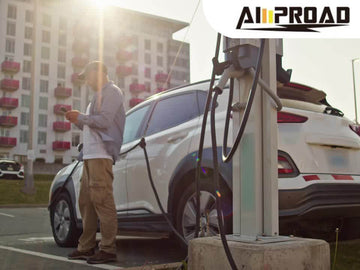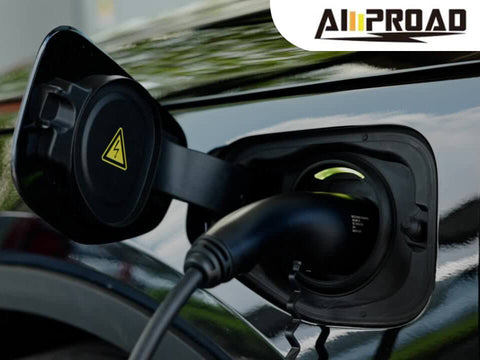
EVSE, or Electric Vehicle Supply Equipment, is the unsung hero behind EV charging. It's the technology that connects your electric vehicle to the power grid, ensuring a safe and efficient charging experience. But what exactly is EVSE, and how does it work? Join us on this journey to demystify EVSE and understand its crucial role in the world of electric vehicles. Whether you're a seasoned EV enthusiast or just starting, we've got you covered!
What Is EVSE?
EVSE, or Electric Vehicle Supply Equipment, is the infrastructure responsible for charging electric vehicles (EVs). It includes charging stations and connectors, facilitating the transfer of electricity from the grid to the EV. EVSE comes in different levels, with Level 1 using standard household outlets and Level 2 employing higher-powered charging stations for faster charging. The various connector types, such as Type 1, Type 2, CHAdeMO, and CCS, cater to different regions and EV models. Understanding EVSE is essential for EV owners, ensuring a seamless and efficient charging process.
And one notable element in the EV charging landscape is the J1772 connector, also known as the J Plug, which serves as the standard for most non-Tesla EVs in North America. However, Tesla owners can bridge the gap with a J1772 to Tesla adapter. This adapter allows Tesla EVs, which typically use proprietary plugs, to connect to J1772 charging stations, expanding their charging compatibility.
The J1772 connector is recognized for its widespread adoption, offering a uniform charging solution for various EV models. Tesla's use of a distinct plug necessitates the adapter for compatibility with the broader charging infrastructure. This thoughtful integration showcases the adaptability of EV technology and fosters a more interconnected and user-friendly charging experience. As the electric vehicle market continues to evolve, the J1772 to Tesla adapter exemplifies the industry's commitment to inclusivity and the seamless integration of diverse EV models into the charging ecosystem.
How does EVSE Work?

Electric Vehicle Supply Equipment (EVSE) is the unsung hero behind the scenes of electric vehicle (EV) charging, ensuring a safe and efficient transfer of power from the electrical grid to your EV. The working mechanism of EVSE involves a well-orchestrated process that begins the moment you plug in your EV.
When you connect your EV to an EVSE charging station, the station's control unit communicates with your vehicle to establish a secure connection. This communication is crucial to initiate and manage the flow of electricity between the grid and the EV's battery.
EVSE comprises three main components: the charging station, the connector, and, in some cases, a control unit. The charging station is the physical infrastructure that delivers power, while the connector is the interface that physically links your EV to the station. The control unit, if present, manages the charging process and ensures it aligns with safety and performance standards.
Depending on the charging level – Level 1 or Level 2 – the charging station adjusts the amount of electricity delivered to your EV. Level 1 charging typically uses a standard household outlet, providing a lower charging rate, while Level 2 charger, including the level 2 portable ev charger, involves a higher-powered EVSE for faster charging.
The connector types can vary globally, with standards like Type 1, Type 2, CHAdeMO, and CCS. The connector must match the port on your EV to ensure a proper connection.
Overall, EVSE orchestrates a carefully choreographed dance between your EV and the charging station, managing the flow of electricity to charge your vehicle efficiently. This process ensures not only a seamless charging experience but also emphasizes the importance of safety and compatibility in the rapidly advancing world of electric mobility. As technology evolves, so does the sophistication of EVSE, contributing to the ongoing growth and accessibility of electric vehicles.
What Is Level 1 and Level 2 Charing?
Exactly the charging levels mentioned above, Level 1 and Level 2 charging are crucial aspects of the electric vehicle (EV) charging landscape. Let's delve into these two levels to understand their significance and how they cater to the diverse needs of EV owners.
Level 1 Charging
Level 1 charging is the most basic and accessible form of EV charging. It utilizes a standard household outlet, making it convenient for EV owners to charge their vehicles at home or anywhere with a typical electrical socket. The charging rate is relatively slower compared to Level 2, but it serves well for overnight charging or when a quick top-up is sufficient.
Level 2 Charging
On the other hand, Level 2 charger is designed for more rapid and efficient charging. It requires a higher-powered Electric Vehicle Supply Equipment (EVSE) and is commonly installed in homes, workplaces, and public charging stations. Level 2 charging significantly reduces charging times compared to Level 1, making it ideal for those who need to charge their EVs more quickly.
The increased charging speed of Level 2 is particularly advantageous for individuals with longer daily commutes or those who require multiple charging sessions in a day. Installing a Level 2 EVSE at home provides the convenience of faster charging without the need for frequent visits to public charging stations.
To bring it all together, while Level 1 charging offers a straightforward and accessible option for basic charging needs, Level 2 charging caters to users who prioritize faster charging times, making it a valuable solution for a more extensive range of electric vehicle applications. As the demand for EVs continues to grow, the availability and accessibility of both Level 1 and Level 2 ev charger options contribute significantly to the widespread adoption and convenience of electric mobility.

Are There Wireless EVSE Options?
In the ever-evolving landscape of electric vehicle (EV) charging, the concept of wireless Electric Vehicle Supply Equipment (EVSE) has emerged as a notable innovation. Unlike traditional wired charging systems, wireless EVSE utilizes technologies like inductive charging to transfer power from the charging station to the EV without the need for physical cables.
The primary component of wireless charging is the charging pad, installed on or embedded in the ground. When an EV equipped with wireless charging capabilities parks over the pad, a magnetic field is created, initiating the transfer of energy to the vehicle's receiving coil.
Wireless EVSE offers a streamlined and convenient charging experience. It eliminates the hassle of plugging and unplugging cables, providing a more user-friendly solution for EV owners. This innovation aligns with the industry's efforts to enhance the ease of EV adoption and make charging more accessible to a broader audience.
While wireless charging is gaining traction, it's important to note that widespread implementation is still in progress. Currently, it is not as prevalent as traditional wired charging infrastructure. However, ongoing advancements in technology and increased collaboration within the electric mobility sector suggest a promising future for wireless EVSE options.
As the electric vehicle market continues to expand, the development and integration of wireless charging technologies underscore the commitment to creating a seamless and efficient charging experience. While wired EVSE remains the dominant and well-established solution, wireless options represent a glimpse into the future of electric vehicle charging, aiming to further simplify and enhance the EV ownership experience.
How to Find EVSE Stations Near Me?
Locating Electric Vehicle Supply Equipment (EVSE) stations has become increasingly convenient with the growing adoption of electric vehicles (EVs) and the expansion of charging infrastructure. Here's how you can easily find EVSE stations near you:
Mobile Apps
Numerous mobile apps dedicated to EV charging provide real-time information about nearby EVSE stations. Apps like PlugShare, ChargePoint, and Tesla's Supercharger app offer maps, station details, availability, and user reviews. These apps are user-friendly and cater to a variety of EV models.

Online Platforms
Several online platforms offer interactive maps and databases of EVSE stations. Websites like PlugShare.com, ChargePoint.com, and the U.S. Department of Energy's Alternative Fuels Data Center provide comprehensive information, allowing users to plan routes and identify charging locations.
In-Car Navigation Systems
Many modern electric vehicles are equipped with in-car navigation systems that include real-time EVSE station information. These systems often display charging station locations along with details such as available connectors and charging speeds.
EV Manufacturer Websites
Check the official websites of your EV manufacturer. Many automakers provide tools or maps to help EV owners locate charging stations that are compatible with their specific vehicles.
Government Initiatives
Government websites and initiatives promoting electric mobility often offer resources to find EVSE stations. For example, the U.S. Department of Energy's Alternative Fuels Data Center provides an interactive map showcasing public charging stations across the country.
Charging Networks
EV charging networks like ChargePoint, EVgo, and Tesla Supercharger have their own websites or apps with information on station locations, availability, and charging rates.
With these resources at your fingertips, finding EVSE stations near you becomes a straightforward process. Whether you're planning a road trip or need to charge locally, the availability of information through various channels makes the electric vehicle charging experience more accessible and user-friendly.
Can You Install EVSE at Home?
Absolutely, installing Electric Vehicle Supply Equipment (EVSE) at home is a practical and increasingly common choice for electric vehicle (EV) owners. It offers the convenience of charging your EV overnight, ensuring a fully charged vehicle each morning. Many EV manufacturers provide home charging solutions, including Level 2 chargers that require professional installation.
For a seamless home charging experience, Amproad, a leading Level 2 Charger and car jump starter manufacturer focusing on the American and Canadian markets, offers an affordable EV home charger. Their Level 2 charger, along with a NEMA 14-50R adapter cord, provides a versatile charging solution compatible with a wide range of EV models. These products, having passed rigorous testing, guarantee a safe and efficient way to meet your home charging needs. Additionally, Amproad's expertise extends to car jump starter, providing a dual-purpose device to both recharge your EV and jump-start your car. Installing EVSE at home with trusted solutions like Amproad ensures a reliable and convenient charging experience, contributing to the seamless integration of electric vehicles into daily life.
Contents for conventional cars owners:


